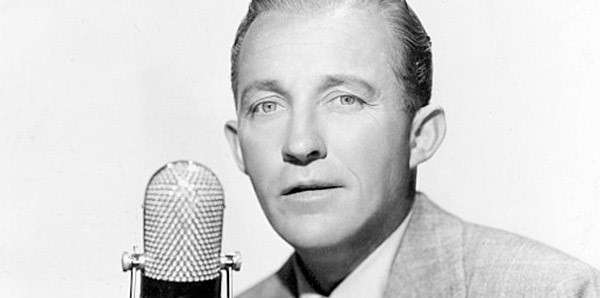Bing Crosby sang such hit songs as the ever-popular holiday classic “White Christmas.” The beloved crooner was also a star of radio, movies and television. This week, we take a look at the life, music and history of one of America’s best known crooners.
Courtesy of Biography.com. We do not own rights to this content.
Who Was Bing Crosby?
Bing Crosby is one of America’s most popular entertainers of all time. In 1931, Crosby launched his hugely popular radio show. He soon started starring in films, winning an Academy Award for Going My Way in 1944. Throughout much of his career, Crosby dominated the music charts with nearly 300 hit singles to his credit. He died in 1977.
Early Life
Crosby was the fourth of seven children born to a working-class family. Crosby spent his early years in Tacoma, Washington, before moving to Spokane when he was six years old.
With the move to Spokane came the purchase of a revolutionary device — the phonograph. Crosby loved playing music on the phonograph, especially the work of Al Jolson. Crosby earned his famous nickname around the age of seven; “Bing” comes from a comic strip he adored, “The Bingville Bugle.”
For his education, Crosby attended Catholic school, reflecting his mother’s deep devotion to her faith. He went to Gonzaga High School, which was run by Jesuits. While attending Gonzaga University, Crosby abandoned his aspirations to become a lawyer for his dreams of musical stardom. He performed with a group called the Musicaladers as a singer and a drummer.
Early Career: Music and Radio
In the mid-1920s, Crosby formed a duo with his friend, Al Rinker, and the pair went to Los Angeles in hopes of landing their big break. They quickly became a popular vaudeville act, which they called “Two Boys and a Piano,” and played numerous shows on the West Coast. The duo joined Paul Whiteman and his jazz band for a time and then formed a trio with Harry Barris known as the Rhythm Boys. The Rhythm Boys often performed as part of Whiteman’s act. Many of Crosby’s early songs reflected his love for jazz and its influence on his sound. He was skilled at scat-singing and showed a talent for jazz-style phrasing.
In addition to releasing a few singles, the Rhythm Boys appeared together in one of Crosby’s first films, 1930’s King of Jazz. Crosby soon launched his solo career, landing his own radio show. Debuting in 1931, his radio program became a big success, attracting as many as 50 million listeners during its peak, and lasting nearly 30 years on the airwaves.
That same year, Crosby scored a number of hits with such songs as “I Found a Million-Dollar Baby” and “Just One More Chance.” He continued to delight music buyers over the coming years with “Please,” “You’re Getting to Be a Habit With Me” and “June in January.”
On the Big Screen
In the early 1930s, Crosby signed a contract with Paramount Pictures. His slim frame and protruding ears may not have been the features of a traditionally handsome leading man, but Crosby’s easy charm and smooth patter quickly won over film audiences. He started out in a number of musical comedies, such as 1934’s Here Is My Heart, with Kitty Carlisle; and 1936’s Anything Goes, with Ethel Merman. Crosby also starred in 1936’s Pennies from Heaven, which gave him another hit single with its title track.
Crosby’s film career continued to flourish, reaching its peak in the 1940s. He co-starred with comedian Bob Hope in the wildly popular series of Road pictures, which began with 1940s The Road to Singapore. The on-screen dynamic duo forged a genuine affection for each other off-screen as well. Crosby and Hope remained friends for life, and appeared together in numerous films. With Dorothy Lamour along as their female lead, they made seven Road movies together.
The following year, Crosby teamed up with another musical star, Fred Astaire, for Holiday Inn. The film featured music by Irving Berlin, including one of Crosby’s all-time greatest hits, “White Christmas.” Taking a paternal turn, Crosby starred as Father Chuck O’Malley in 1944’s Going My Way. He played a warm and worldly Roman Catholic priest, who helps straighten out a group of young kids and, in turn, helps his parish. This dramatic role netted Crosby his one and only Academy Award win, which reprised for 1945’s The Bells of St. Mary’s.
Returning to light comedies, Crosby reunited with Hope for 1946’s Road to Utopia and 1947’s Road to Rio. According to some reports, Crosby was the top box office star from 1944 to 1947. To this day, he remains one of the all-time top-grossing film performers. Crosby continued to appear in musicals, such as 1954’s White Christmas, with Danny Kaye and Rosemary Clooney. With the movie’s title song, Crosby once again scored a Top 10 hit. He had more than 300 hit singles during his long career.
That same year, Crosby gave what some critics call his best dramatic performance. He played an alcoholic actor in The Country Girl, with Grace Kelly playing his wife. Crosby received his final Academy Award nomination for his work on the film. Two years later, he and Kelly teamed up again for the musical comedy High Society, along with fellow crooner Frank Sinatra. Crosby made his last Road film with Hope and Dorothy Lamour in 1962’s The Road to Hong Kong.
Final Years
While his film work tapered off in the 1960s, Crosby focused more on the small screen. He appeared in numerous televisions specials and, from 1964 to 1970, hosted the variety program The Hollywood Palace. He also tried his hand at situation comedy in 1964, with The Bing Crosby Show, but the series was short-lived.
Crosby and his family — his three children from his second marriage — became holiday favorites as they appeared in their own Christmas special each year in the 1970s. In the 1977 special, Bing Crosby’s Merrie Olde Christmas, he performed a duet with David Bowie on two holiday classics, “Peace on Earth” and “The Little Drummer Boy.” The show and tracks were recorded several weeks before Crosby’s death. Crosby also enjoyed making guest appearances on such programs as The Tonight Show and The Carol Burnett Show.
Death and Legacy
A golf devotee, Crosby helped establish the Bing Crosby National Pro-Amateur tournament in the late 1930s. He continued to play his beloved sport during his last years and died while golfing in Spain on October 14, 1977. He had suffered a heart attack after playing 18 holes on a course near Madrid. Crosby’s family and fans were devastated by the news of his passing. According to his longtime friend, Bob Hope, “If friends could have been made to order, I would have asked for one like Bing.”
A special memorial was held at New York City’s St. Patrick’s Cathedral shortly after Crosby’s death. Nearly 3,000 admirers attended the ceremony, to remember and honor the late entertainer. Crosby’s family also held a small private funeral for the singer in Culver City, California, which was attended by Bob Hope and Rosemary Clooney, among a few other close friends of Crosby’s from Hollywood.
Crosby was laid to rest next to his first wife, Dixie Lee. The couple had been married from 1930 to 1952 when she died of ovarian cancer. Crosby was survived by his four sons from his first marriage, Gary, Lindsay, Phillip and Dennis; as well as by his second wife, Kathryn, and their three children, Nathaniel, Harry and Mary Frances.
Several years after his death, Crosby’s reputation as the mellow, cool paternal type was shattered by allegations made by his son Gary. He claimed in his 1983 tell-all memoir Going My Own Way that Bing was a cruel father who used to physically abuse his sons. Gary’s brothers were divided on the book. Phillip played down these claims, but Lindsay supported Gary’s stories.
As the new millennium began, a public effort ignited to remember Crosby and restore some of his legacy. Jazz critic Gary Giddins re-examined the singer’s early work in Bing Crosby: A Pocketful of Dreams (2001). In 2005, the Film Society of Lincoln Center hosted a retrospective of Crosby’s films. Regardless of what he did or didn’t do in his personal life, Crosby changed the sound and style of popular music. His songs are a part of the American soundtrack, and can still be heard on the radio, on television programs and in films.
Videos Of The Week:

